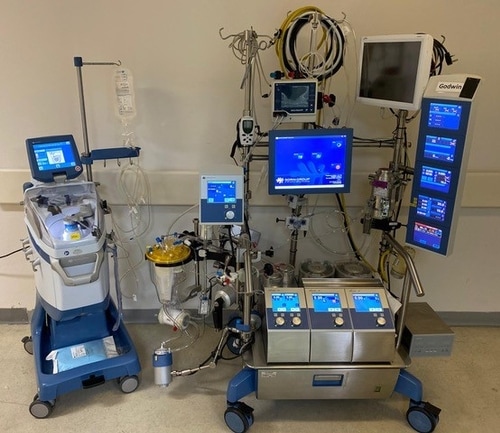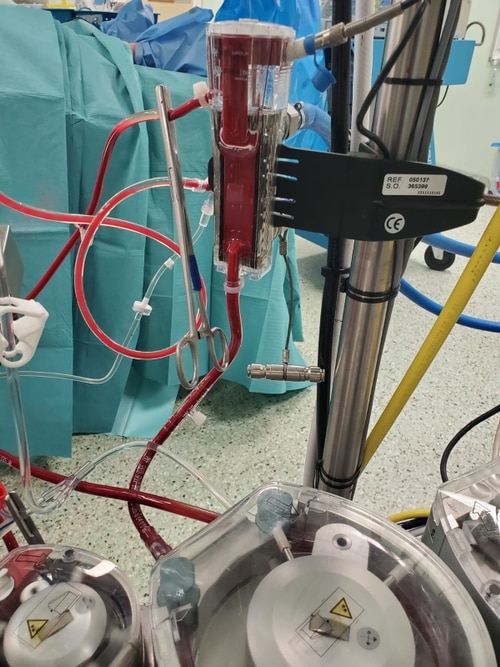What is a Perfusionist?
A Perfusionist is a specialised healthcare professional whose main responsibility is the operation and maintenance of the cardiopulmonary bypass machine (heart lung machine).
Mainly seen in a cardiac setting, the machine provides blood flow and regulation of oxygen and carbon dioxide. This facilitates a surgeon operating on or inside the heart to sustain the patient’s life during their operation.

Example of some adult cardiac procedures requiring CPB
- Coronary Artery Bypass Graft(s).
- Atrial Myxomas.
- Tricuspid Valve Repair.
- Mitral Valve Repair/Mitral Valve Replacement.
- Aortic Valve Replacements.
- Dissections/Aneurysms/Trauma of the aorta (type 1 / 2 dissection).
- Lung Transplant.
- Heart Transplant.
- Aortic Root Replacements.
Heart Lung Machine
Operation of the heart lung machine is the main role of a Perfusionist. The Liva Nova H5 is an example of a heart lung machine base. During each operation sterile disposable equipment is prepared for the heart lung machine. The basic components of this are a venous reservoir, pump, oxygenator, heat exchange device, arterial line filter and cardioplegia.
Venous Reservoir
Venous reservoirs collect blood drained from the surgical field. Open reservoirs are the most used. They contain both defoaming agents and filters in order to minimise gaseous and lipid emboli from the surgical field from getting into the patients’ circulation. Its main advantages over closed reservoirs are that it capable managing air, vacuum assisted drainage can be used and it’s simpler and it does not require separate system to manage suction blood. Closed reservoirs provide better sterility, a smaller surface area for blood to contact which produces less of an inflammatory response to cardiopulmonary bypass compared to open systems.
Pump
There are two main types of arterial pumps, Roller and centrifugal. Roller pumps positively displace blood through tubing with two rollers using peristaltic motion. Centrifugal pumps worked via a nest of smooth plastic cones within a plastic casing. These cones are magnetically coupled (at the base) with an electric motor and, when rotated rapidly, generate a vortex, sucking blood into the pump. As the blood enters the spinning pump, positive pressure is generated by centrifugal force imparting kinetic energy, and blood is expelled from the outlet towards the patient.
Oxygenator, heat exchange device and arterial line filter
Membrane oxygenators consist of hollow microporous polypropylene fibres (100–200 μm internal diameter). Gas flows inside the fibre whilst blood flows outside which facilitates diffusion of O2 into of the blood and CO2 out of the blood. The CO2 is exhausted through exhaust ports in the device. In modern oxygenators both heat exchange device and arterial line filters are integrated into one device to minimise haemodilution. Heat exchange device is located post pump but pre-oxygenator responsible.
Cardioplegia
Cardioplegia is a form of myocardial protection and is necessary for many cardiac operations. The patients ascending aorta is clamped with a cross clamp. Distal to the cross clamp is the arterial cannula which delivers oxygenated blood to the body. Proximal to the cross clamp is the aortic root cannula which can both distribute and remove cardioplegia solutions.
The aim of cardioplegia is to electrochemically arrest the heart, which reduces oxygen consumption in the heart and helps to facilitate a surgeon to operate by providing a still heart and a bloodless field. After the operation is complete the cross clamp is removed, washing away the cardioplegia solution and returning the electrochemical activity to the heart. The solution is given both warm (37 °C) and cold (4°C). The most common cardioplegia solution uses high concentration of potassium to produce a diastolic arrest of the heart. The solution is commonly mixed with blood at a varying ratio from 1:1 to 1:8 (cardioplegia: blood). In addition, substances such as adenosine, bicarbonate, calcium, glucose, glutamate, mannitol, magnesium, procaine, and others may be added.
